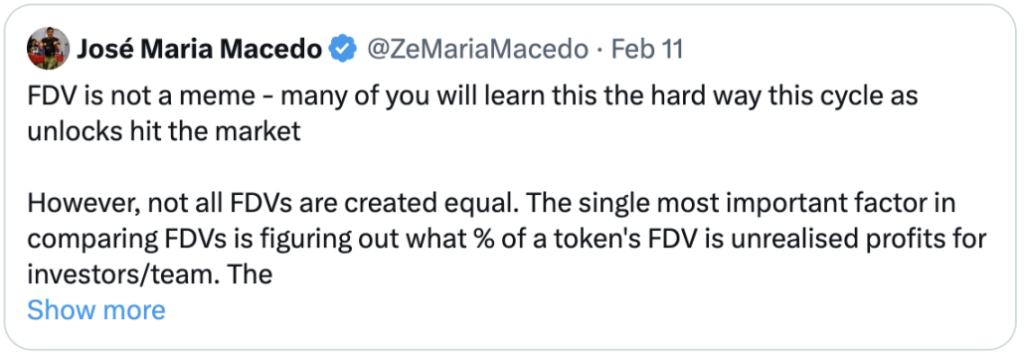F DV is indeed not a meme, and since this article was published I have been talking to OTC brokers trying to understand the secondary market structure of the assets I short. The findings are revealing, so I wanted to share them with you. All in all, I don't think these are bullish unlocks.

Many of these assets have active sellers, but few offer bids below 70% of the market price (we're talking standard SAFT or Simple Token Agreements with a 1 year cliff period and a 2/3 year vested period ).
In terms of trading volume, my rough estimate based on conversations with different brokers is that SAFT's total trading volume is about $100 million. Considering these assets will have tens of billions of dollars in cumulative unrealized gains unlocked over the next few years, that's basically the end of the story.
To put it bluntly, Bullish Unlock wants to see the lowest possible unrealized gains to market value ratio, as explained in the linked article.
Most coins are sitting on substantial unrealized gains from the team (0 cost basis) and early investors (you can calculate this yourself using tools like cryptorank.io). Coupled with extremely low floating rates (generally 5-15%), the trading price of most projects is 4-8 times the market value of unrealized gains. In other words, the total circulating market value of the project is 4-8 times the unrealized market value. Realize benefits.
Assuming 2 years from Cliff Day, this means that assets worth the entire market value will be unlocked every 3-6 months. This makes it difficult to attract buyers, especially when their alternative beta positions are in memecoins and other assets that don’t have an oversupply.
One way to reduce this effect (besides increasing the initial float) is high pre-issuance secondary trading volume, ideally as close as possible to the current market price. This helps reset the cost basis of unlocked tokens and radically lowers the unrealized gain to market cap ratio (e.g. the now famous Multicoin SOL assist resulting in the first unlock)
Unfortunately, I don't see this happening in the OTC market. Related to this, I'm trying to understand the market structure. I don't want to single out specific assets, but there are many assets with the following characteristics
- extremely high unrealized earnings to market value ratio;
- Even if it is ~70% lower than the market price, there is no secondary demand;
- The funding rate on Binance continues to be positive, and the open interest (Open Interest) reaches 8 figures;
Who would covet these things on CEX but not be interested in buying the secondary market at a discount of more than 70%?
My hypothesis is just that there are special frictions on both the buyer and seller side. I don't know much about the buy side, but I think if they're spending money to be long on these things, they're likely unsophisticated retail gamblers who don't understand vesting schedules or OTC platforms.
Sellers may include:
- Founders/Teams who have over 90% of their new coins in locked token bags, so there is no tendency to collateralize or short;
- Investors in venture capital funds who are unable or do not have the setup to short assets on CEX;
This is why the opportunity to short these assets and profit from them still exists.
By the way, unlike what the CT doomsayers will tell you, this does not mean that all cryptocurrencies are scams, or even that all assets with high unrealized gains market cap will go to zero.
I'm very bullish on cryptocurrencies and believe there will be some category winners that rise through their unlocks because they do have real-world applications.
However, there will also be situations where long-tail assets “return to zero”. This is natural and what you would expect in an asset class that provides liquidity to early-stage venture capital. After all, most ventures fail. In traditional venture capital, only a handful of elite companies are listed and liquid, while long-tail projects fail quietly.
In the cryptocurrency space, a higher proportion of venture capital projects end up with not only spot liquidity, but even liquid derivatives markets. This is unheard of in traditional venture capital and is what makes crypto venture capital a unique asset class.
It also means that long-tail failures in crypto ventures will be public and painful, with both parties making or losing significant amounts of money, rather than failing quietly.
This also means that there will be more structural short opportunities in cryptocurrencies than in any other asset class. To a certain extent, you can basically bet your money on the empirical fact that most startups fail.







